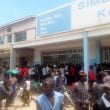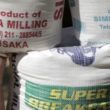The Food Reserve Agency (FRA) says its ongoing community sales where 50Kg bags of white maize being sold to communities at K111 are not exploitative because buyers are benefiting with more mealie meal.
And the FRA says it has sufficiently positioned maize stocks in various parts of Zambia that are threatened with hunger in light of increased demand for maize from the DMMU and vulnerable people in various communities.
In an interview, Monday, FRA executive director Chola Kafwabulula refuted suggestions that the Agency was exploiting vulnerable communities by offloading a 50Kg bag of maize at K111.
This comes after the FRA pegged its maize purchase price from farmers of K70 per 50Kg bag for last year’s crop marketing season.
“The community sales are going on very well, but let me comment on the price. The concern from the public has been that, we are selling to the communities a 50Kg bag of maize at K111, whilst a 25Kg bag of mealie meal is going for about K100, K110. So, people are saying that ‘we are exploiting the households,’ we are not,” Kafwabulula said.
“In fact, what it is this: our communities must not compare a 25Kg bag (of mealie meal), which is going for K110 to a 50Kg bag of maize. If you want to compare, you should compare ‘like with like,’ meaning the 50Kg bag of maize, which is going for K111 should first be translated into mealie meal. So, when the communities take the 50Kg bag of maize to the hammer mill, they will get about 47Kg of mealie meal, that’s the logic. So, 47Kg of mealie meal from a 50Kg bag of maize is almost two X 25Kg bags of mealie meal, meaning that this is very cheap if you translate it into mealie meal.”
He explained that offloading maize to households was actually more effective than selling to millers.
“That is why, historically, selling maize to households has proved to be more effective in reaching out to the communities as opposed to selling to millers. So, people shouldn’t look at the 50Kg bag of maize, they should ask the question how much mealie meal are they getting from that,” said Kafwabulula.
“So, when they go to the hammer mill, the conversion rate is far much higher than passing through a milling plant because a milling plant has got other overheads, which are passed to the consumer.”
And the FRA announced that it had sufficiently positioned maize stocks in various parts of the country that were threatened with hunger in light of increased demand for maize from the Disaster Management and Mitigation Unit (DMMU), and vulnerable people in various communities.
In a statement released, Monday, FRA public relations officer Daniel M’soka stated that the Agency had so far supplied to the DMMU 6,555 metric tonnes of maize and sold slightly over 3,000 tonnes to vulnerable people in various communities in order to mitigate hunger since the beginning of this year.
According to M’soka, there had been increased demand for maize from Central, Eastern, Luapula, Lusaka, Muchinga, North-Western, Southern and Western provinces resulting in the combined supply by FRA of over 9,000 metric tonnes of maize valued at over K19 million.
“The demand for FRA maize has apparently been driven by crop failure experienced by farmers as a result of dry spells some parts of the country faced during the last rainy season. FRA sales to DMMU are largely targeted at schools, hospices, orphanages and hospitals whereas sales to vulnerable communities are administered through the office of the District Commissioners throughout the country,” stated M’soka, who added that the Agency had enough maize stocks to avert hunger and had put measures in place to quickly respond to any food relief emergency.












